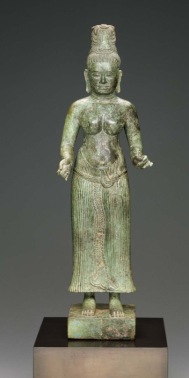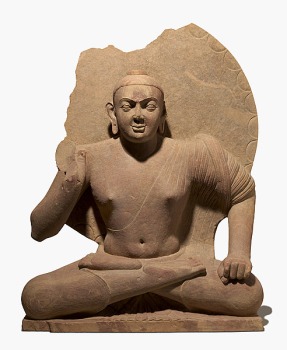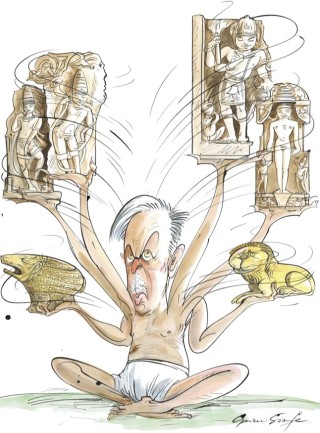In the wake of the arrest of the Manhattan antiquities dealer Nancy Wiener, we’re teaming up with our friends at the India Pride Project to track down the ancient objects she and her mother Doris Wiener sold to museums and private collectors around the world. And we need your help.
 Prosecutors allege the two conspired for decades with a network of smugglers and middlemen to obtain looted and stolen antiquities from across Asia. Many of those objects passed through auction houses before being purchased by museums and private collectors. (See our earlier coverage here.)
Prosecutors allege the two conspired for decades with a network of smugglers and middlemen to obtain looted and stolen antiquities from across Asia. Many of those objects passed through auction houses before being purchased by museums and private collectors. (See our earlier coverage here.)
Where are these objects today? Where did they come from? And how many of them have a documented ownership history that stands up to scrutiny?
To answer those questions, we want your help searching Asian art collections around the globe for objects tied to the Wieners. As we find them, we’ll post them here, examine their ownership histories and, with IPP’s help, try to identify where they may have come from.
Here’s how you can chip in:
- Search the online archives of major Asian art collections around the world for objects tied to Nancy or Doris Wieners or their galleries. For collections that don’t have comprehensive online catalogs, contact the institution and politely ask for information on any objects acquired or donated by either of the Wieners.
- When you find an object, post a link to it in the comments below along with the object’s stated ownership history (if any is provided). Or email me at chasingaphrodite@gmail.com. We’ll credit you with the find unless you prefer to remain anonymous. Anonymous tips are also welcome, especially when they come with documents. We’re serious about protecting the identity of sources.
- As we find Wiener objects, we’ll add them to a list below along with suggestions for additional research steps.
FINDINGS
UPDATED 2/5/17: In our first month, readers have found dozens of objects tied to Nancy and Doris Wiener at museums around the world. Several require additional research.
The Boston Museum of Fine Art and the Freer and Sackler Gallery have both reached out to share ownership histories of Wiener objects in their collections.
Smithsonian’s Freer and Sackler Gallery
Keri Douglas (@keridouglas) identified three objects at the Smithsonian’s Freer and Sackler Galleries tied to Doris Wiener. Of particular note is this Chola bronze (F2003.2) from Tamil Nadu, India, the source of hundreds of looted objects identified in the case against Subhash Kapoor, who did business with the Wieners.
UPDATE 1/31/17: The Freer and Sackler’s head of collections management Elizabeth Duly reached out to say the museum has posted provenance details for the four objects on its Provenance Research page. We’re grateful for the museum’s openness.
The ownership history for the Chola bronze has several red flags. It includes an invoice stating that Doris Wiener bought the object from Rajrama Art Galleries in London in March 1973, six months after India passed its national patrimony law in September 1972.
Wiener claimed in a 1995 letter to then curator Vidya Dehejia that she had actually purchased the bronze months earlier and that it was seen in 1973 by Indian art authority Pratapaditya Pal. It’s unclear what motivated the letter. The story suggests that Wiener held the valuable bronze for 29 years – without publication or sale – before selling it to the Smithsonian in 2002.
We asked Vijay Kumar, an expert on South Indian art and smuggling networks who has consulted for U.S. law enforcement, to review the museum’s posting. “The given paperwork is straightaway problematic since the bronze has no provenance pre 1972 and no information on how it reached London pre 1972,” Kumar wrote. As for the 1995 letter, “There is no apparent reason for this explanation but an attempt to push the objects acquisition back by a year.”
Observing the patina, Kumar noted the condition of the bronze – especially the holes in the reverse and on the base pedestal – suggest it may have come from a buried hoard rather than an active temple.
“India should stake its claim for this bronze purely on the basis of no documented provenance pre 1973 and also take the official statements of the celebrated scholars in this case,” Kumar concluded.
Given the Wieners have been accused of fabricating ownership histories for decades, we agree it would be wise to further investigate these claims.
Next steps: As a federal agency, the Smithsonian museums are subject to Freedom of Information Requests. We should request all documents related to the acquisition of these objects.
Boston Museum of Fine Art

Female Khmer Deity
Victoria Reed, the curator of provenance at the Boston MFA, reached out pro-actively to share five objects the MFA acquired from Doris Wiener. They are:
Recumbent Bull (1988.434). 11th Century sandstone sculpture from Cambodia. Sold by Doris Wiener, Inc., New York, to the MFA. on October 26, 1988. No known provenance. No photo available.
Female Khmer Deity (1988.484). Doris Wiener apparently told museum the sculpture had been discovered near Wat Phu, Champasak Province, Laos and was first offered to a “Bangkok art collector” in early 1980s. Wiener sold it to the MFA on December 21, 1988.
Next step: Who is the “Bangkok art collector?” Might it be Douglas Latchford? Are there archival photos of objects at War Phu?
Shiva as Lord of Dance (1992.12) The sandstone sculpture from Central-eastern Madhya Pradesh was acquired by Doris Wiener in 1991. She sold it to the MFA on February 26, 1992. The museum has no other provenance.
Next step: Stylistically, what sites in central-eastern Madhya Pradesh could this sculpture could be associated with? Were those sites documented during colonial times?

Krishna Celebrates Holi (2002.901) Watercolor dating to 1750 – 60. Doris Wiener claimed to acquire the painting in 1972 and sold it to Paul F. Walter, New York; The painting was sold on November 14, 2002 at Sotheby’s, New York, lot 29, to the MFA.
Tibetan Avalokiteshvara (2003.339) According to a July 29, 2003 signed statement from art dealer Leonidas (Aleko) Goulandris, his gallery Arjuna Arts, Ltd. acquired the sculpture at Spink and Son, London, in 1967 and sold it to Doris Wiener in 2003. That same year, on September 17, Wiener sold it to the MFA.
Next step: Need someone to contact Goulandris to confirm the story and learn whether there is additional information about the sculpture’s origins prior to Spink and Son.

Avalokiteshvara
Art Gallery of New South Wales
Reader Judith Gibson pointed us to this 10th century Durga Slaying the Buffalo at the Art Gallery New South Wales (163.1999). The Australian museum, currently run by former Getty director Michael Brand, says it is investigating the origins of the sculpture, which was acquired from Nancy Wiener, who claimed to have it since 1999. The Australian has reported that Wiener sold it to the museum in 1999 for $95,000 without any proof of prior ownership. Wiener did not respond to the newspapers inquiries.
Next step: Inquire with the museum what steps it is taking to investigate the Durga.

Durga Slaying the Buffalo
Musee Guimet
 A confidential source pointed us to this Kushan Buddha at the Musee Guimet in Paris. The source believes Doris Wiener may have sold the sculpture, which is strikingly similar to Kushan Buddhas her daughter Nancy sold with false provenance to the National Gallery of Australia and Singapore’s Asian Civilizations Museum. As the criminal complaint detailed, these Seated Buddhas were allegedly stolen by the notorious convicted idol thief Vaman Ghiya.
A confidential source pointed us to this Kushan Buddha at the Musee Guimet in Paris. The source believes Doris Wiener may have sold the sculpture, which is strikingly similar to Kushan Buddhas her daughter Nancy sold with false provenance to the National Gallery of Australia and Singapore’s Asian Civilizations Museum. As the criminal complaint detailed, these Seated Buddhas were allegedly stolen by the notorious convicted idol thief Vaman Ghiya.
Next steps: Someone, preferably a French speaker, needs to contact the Guimet and politely inquire about the Guimet Buddha’s provenance. We should also ask for details on any other objects acquired from the Wieners.
ADDITIONAL LEADS
Here are some more leads to follow…
Museums
On her website, Nancy Wiener boasts of selling Asian art to museums around the world, including:
Metropolitan Museum of Art
Asia Society
The Los Angeles County Museum
The Art Institute of Chicago
The Nelson-Atkins Museum
The Asian Civilizations Museum in Singapore
Doris Wiener, who started dealing Asian art in the 1960s, is said to have sold objects to:
The Metropolitan Museum of Art
The Cleveland Museum of Art
The Norton Simon Museum
Asia Society
The Brooklyn Museum
This is obviously an incomplete list, so other museums with Asian art collections should also be searched or contacted. Don’t forget about University museums and collections.
As a starting point, try the museum’s online collection records, which can often be searched by ownership history. For example, the Metropolitan Museum of Art’s online collection shows 10 objects tied to Doris Wiener and 6 objects associated with Nancy Wiener. (We’ll contact the Met about those and post their response.)
For museums that don’t have complete provenance information online, which is most, please contact the museum and politely request a complete list of objects from the Wieners, along with all available provenance information for those objects. You may have to be persistent – this is information should be readily available to the public, but many museums are reluctant to release it. It may be helpful to note the antiquities policy of the Association of Art Museum Directors, which states:
AAMD is committed to the exercise of due diligence in the acquisition process, in particular in the research of proposed acquisitions, transparency in the policy applicable to acquisitions generally, and full and prompt disclosure following acquisition.
Museums that seek to be transparent and proactive should post all of their Wiener objects – with a complete ownership history – on their Provenance pages, as the National Gallery of Australia did (belatedly) in response to the Kapoor investigation. This is a clear signal of an institution’s good faith.
Auction Houses
Most major auction houses have online searchable sales archives that include some (but sadly not all) provenance information. Look for any objects that passed through the Nancy or Doris Wiener.
Once you find them, we’ll have to track down where they are today. Some creative Google searching can often work, as can reverse image searches on Google images or TinEye.
There’s also the Doris Wiener Collection. When Doris Wiener died in 2011, Christie’s sold a collection of 380 her objects. The criminal complaint against Nancy Wiener describes how many of those objects came through Asian smuggling networks.
Where are they today? Some were likely acquired by museums, while others were probably purchased by private collectors. Unless Christie’s releases this information, some sleuthing (or tipsters) will be required to track them down.
Like museums, auction houses who have done business with the Wieners should be proactive and transparent by posting complete information on objects they’ve sold tied to the Wieners. This will send a clear signal to the public that they’re not interested in protecting art traffickers.
Private Collectors
Doris Wiener is said to have sold antiquities to leading collectors, including John D. Rockefeller III, Igor Stravinsky and Jacqueline Kennedy. Nancy Wiener also sold to prominent private collectors.
What came of those collections? Where are those objects today? Private collections are difficult to search unless they’ve been published in a catalog or loaned to a museum or gallery show.
Some private collectors may want to come forward in good faith, and we should encourage them. If you own an object sold by Nancy or Doris Wiener – or know someone who does – email me here and share what you can. We may be help to help you assess its origins.
Dealer Catalogs
Many galleries publish sales catalogs of their inventory. Did Doris or Nancy Wiener? Can we track them down?
The Nancy Wiener Gallery’s website has posted images of objects she was selling over the years. The Internet Archive can be used to search it back to 2011: http://web.archive.org/web/*/http://www.nancywiener.com
Happy hunting!

 Antiquities dealer Nancy Wiener was arrested Wednesday morning in Manhattan and charged with conspiring with international smuggling networks to buy, smuggle, launder and sell millions of dollars worth of stolen Asian art thru leading auction houses.
Antiquities dealer Nancy Wiener was arrested Wednesday morning in Manhattan and charged with conspiring with international smuggling networks to buy, smuggle, launder and sell millions of dollars worth of stolen Asian art thru leading auction houses.
 She sold the first to Singapore’s ACM without being asked to provide its ownership history, the complaint states. After I repeatedly asked the museum to release its records (to no avail), the museum appears to have contacted Wiener for additional information.
She sold the first to Singapore’s ACM without being asked to provide its ownership history, the complaint states. After I repeatedly asked the museum to release its records (to no avail), the museum appears to have contacted Wiener for additional information.
 When Wiener consigned a Cambodian sculpture of 11th century Shiva at a 2011 auction at Sotheby’s, the auction house noted that cracks in the sculpture “had been dressed up with plaint splatters to mask repairs” – a clear sign of looting, according to the complaint.
When Wiener consigned a Cambodian sculpture of 11th century Shiva at a 2011 auction at Sotheby’s, the auction house noted that cracks in the sculpture “had been dressed up with plaint splatters to mask repairs” – a clear sign of looting, according to the complaint.
